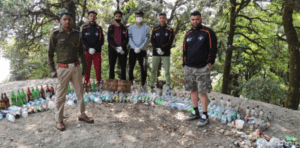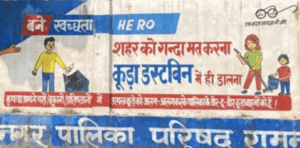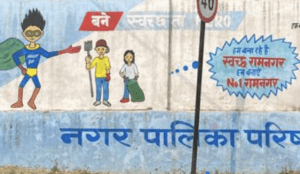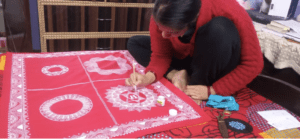Unit developed by Neena Sarin and Rachna Nath (YHS Fulbright-Hays 2022)

Proficiency Level: Advanced Low/Mid
Time: 6 x 75 minutes
Objectives: By implementing critical thinking, problem-solving and creativity skills, students will be able to:
- describe environmental issues in Nainital.
- understand the history of the place, geography, culture and stories of Nainital.
- identify the characteristics of an effective community volunteer.
- describe how and why community volunteers are real superheroes
- suggest at least one way to help the Nainital community in their efforts to protect the environment
- describe activities of individuals and communities in relation to nature and crisis situations
- define main characteristics of a hero/heroine and provide examples
- explain a few issues related to landslides
- suggest solutions to counteract landslides
Language structures: Students will be able to use:
- passive voice: past participle of transitive verbs + जाना (e.g.बनाया जाता है, X की सफ़ाई की जाती है, सजाया जाता है)
- conjunct verbs: X + का/की + noun + करना (e.g. X की मदद की: हमें एक दूसरे की मदद करनी चाहिए, X की कोशिश करना, X का सहारा करना) and X + adjective + करना (e.g. X साफ़ करना, X शुरू करना, X बाद करना)
- compound verbs: verb stem + लेना, देना, जाना, बैठना, डालना, पड़ना, उठना, रखना (e.g. कर लिया vs कर दिया)
- progressive and frequentative aspect: present participle + रहना or जाना (e.g. होता रहता है, बढ़ता जाता है) and past participle in masculine singular form + करना (e.g. हुआ करते थे, आया करते हैं)
- subjunctive expressing a wish, suggestion, hesitation: e.g. जंगल/वन बचाने के लिए क्या करें; जो सरकार नहीं कर रही है उसके लिए NGO कौन से कदम उठाएं?
- subjunctive in complex sentences, where the second clause has a verb in the subjunctive – आशा है कि… + subjunctive, यह ज़रूरी बात है कि… + subjunctive, ताकि + subjunctive (e.g. क्या क्या करें ताकि जंगल बचाएँ?)
- adjectives about personality and character विशेषताएँ: दयालु/ससंवेदनशील (sympathetic), बहादुर/साहसी (brave), कुशल/निपुण (skilled), संसाधन सम्पन्न (resourceful)
- phrases related to environmentalism and eco-justice:
- awareness campaign — जागरूकता / जन जागरण अभियान + चलाना
- super-hero/super-heroine — महानायक / महानायिका
- community’s goals — समुदाय m. के उद्देश्य
- environment — पर्यावरण m.
- conservation — X का संरक्षण m. / को संरक्षित + होना / करना
- sewage system — मलप्रवाह m. का प्रबंध m./ की व्यवस्था f.
- pesticides — कीटनाशक
- to pollute — X का प्रदूषण / X को प्रदूषित करना
- plastic pollution — X का प्लास्टिक प्रदूषण + होना / करना
- solid waste pollution — ठोस अपशिष्ट प्रदूषण
- side effects — प्रभाव m., दुष्प्रभाव m.
- Aipan Art — ऐपण कला f.
- women empowerment — महिला सशक्तिकरण m.
- land slides — भू-कटाव m., भूस्खलन m.
 Performance Task: Imagine you are an environmentalist and you want to know about the local environmental issues that the Nainital residents are facing. You conduct surveys (सर्वेक्षण) and have conversations (बात-चीत ) with the local people and try to find out the causes behind these environmental issues (Formulate 5 questions. Being an Environmentalist, how would you support the efforts of these local residents? Come up with a constructive plan to represent your ideas. The plan should include the grammar structures we practiced and a powerpoint presentation including the following:
Performance Task: Imagine you are an environmentalist and you want to know about the local environmental issues that the Nainital residents are facing. You conduct surveys (सर्वेक्षण) and have conversations (बात-चीत ) with the local people and try to find out the causes behind these environmental issues (Formulate 5 questions. Being an Environmentalist, how would you support the efforts of these local residents? Come up with a constructive plan to represent your ideas. The plan should include the grammar structures we practiced and a powerpoint presentation including the following:
- A detailed description of two environmental problems that are being addressed.
- Research on previous solutions to the problems addressed.
- Your unique solution to one of the problems addressed.
- Advantages of your solutions।
- Steps to make your community aware of the issues addressed।

Background/Entry Knowledge:
Students have been introduced through photos and a presentation to the geography of Nainital and several significant places in Nainital (e.g. Naini lake, Balliya Nala Pangot village, Kumaun University). In addition, they have been offered some information about local NGOs and volunteers working in Nainital for environmental protection and sustainability.
Lesson 1. Yashpal Rawat (2X75 minutes session)
Learning Episodes:
1. Warmup:
- Students are asked who their favorite superheroes are and why.
- In groups students brainstorm about what makes an individual a superhero.
- On the board/smartboard the teacher makes a list of the characteristics of the superheroes the students like.
2. The teacher shows the students segments from a video of Naini lake.
Beautiful Nainital Lake India | नैनीताल की ख़ूबसूरत झील (11:08)
3. While viewing, the teacher stops the video to elicit and list on the board expressions related Naini lake, and to guide student attention to the pollution in and around the lake. The teacher introduces passive voice.
4. The students work in small groups to discuss and list the main reasons for the pollution of Naini lake. They use 3+ passive voice.
5. Students will then share their ideas in the whole group setting. The class creates a list on the board of all ideas. The teacher supports the use of passive verbs and lists them on the board.
6. The teacher introduces the volunteer Yashpal Rawat and his efforts to clean the Naini lake. The teacher draws attention on various compound verbs and the connotation each auxiliary verb brings (e.g. कर दिया vs कर लिया, गिर गया vs गिर पड़ा). Video: https://www.youtube.com/watch?v=N4P59ROD22s
7. In groups, students will discuss the three most important efforts by Yashpal Rawat in cleaning the Naini lake and explain why they are important.
8. Jigsaw: they change groups and compare what their initial group chose as most important and come to a consensus about the three main efforts.
9. The students create a poster on Yashwant Rawat and his activities. The teacher provides ongoing feedback and support.
Additional resources
- Hindi: https://www.jagran.com/uttarakhand/nainital-naini-lake-getting-polluted-by-litter-and-sewer-going-from-nainital-drains-21253907.html
- English: https://www.researchgate.net/publication/342657322_STATUS_OF_POLLUTION_IN_AND_AROUND_NAINITAL_LAKE_NAINITAL_DISTRICT_UTTARAKHAND
Lesson 2 – Jai Janani Jai Bharat (2X75 minutes session)

Learning Episodes:
1. The teacher reviews the areas of achievement and makes a list of the evidence of success. Also, s/he identifies areas of improvement to focus on in the upcoming student work.
2. The teacher makes a short presentation with video and a talk about pollution issues in Nainital forests and shows visuals of plastic dumps in Nainital. (Show: https://www.youtube.com/watch?v=f2A5SLtAgac). S/he explains the use of conjunct verbs.
3. In groups, students brainstorm about the side effects of plastic pollution (solid waste pollution) in the forests of Nainital. They report their ideas to the class and share 3+ conjunct verbs. The teacher maps out the output from the students on board and uses subjunctive form, including subjunctive of the conjunct verbs (आशा है कि… + subjunctive, यह ज़रूरी बात है कि… + subjunctive, ताकि + subjunctive, e.g. X की सफ़ाई हो , X का निर्माण करें).
4. The teacher talks about “Jai Janani  Jai Bharat” volunteer group in Nainital: (a) their efforts to clean the trash in Nainital forests, (b) their tree plantation efforts to protect the environment. Video link:https://www.youtube.com/watch?v=OeWTLve9pAs
Jai Bharat” volunteer group in Nainital: (a) their efforts to clean the trash in Nainital forests, (b) their tree plantation efforts to protect the environment. Video link:https://www.youtube.com/watch?v=OeWTLve9pAs
5. In think-pair-share configuration, students note down which initiative they like the most and think about why. They list 3+ reasons and use conjunct verbs and compounds.
6. In larger groups, students think from the point of view of public officials and prioritize one initiative, come to a consensus and explain why they chose it to finance the initiative. They report their decision to the local municipal environment committee about why a specific effort of the “Jai Janani Jai Bharat” group is worth financing
7. The teacher supports their writing with language chunks on the board (prepares them for the upcoming task–reading the article)
8. Students read the article: https://nainitaltoday.com/nainital/nainital-jai-janani-jai-bharat-team-launched-cleanliness-drive-2/
9. Students, in small groups, in the role of a journalist team, write a report for the local newspaper, in which they feature the efforts of the organization as a super heroes’ organization and nominate it for the Annual Award “Our Heroes and Heroines”.
- Role: Journalist
- Audience: The local municipal environment committee
- Format: Power point presentation
- Topic: Heroes saving the environment
 The required content includes:
The required content includes:
- introduction to the organization they chose and why the members of the Jai Janani Jai Bharat are true superheroes.
- specific initiatives worth mentioning and their impact
- reasons to nominate
- 3+ complex sentences with verbs in the subjunctive form (highlight in purple)
- 3+ conjunct verbs (highlight in purple)
- 3+ compound verbs (highlight in purple)
- 3+ verbs in the passive voice (highlight in purple)
- 5+ expressions from the article (highlight in yellow)
10. Gallery Walk: One students from each group remains in their station to summarize for the visitors their main points, and the rest visit other groups’ stations to hear their summaries. The students change places. The goal is to add 2 more points to their own write up.
Lesson 3. Women Empowerment S3 Group – Jay Joshi ( 2X75 minutes)

Learning Episodes:
1. The teacher highlights areas of achievement from the student work and lists grammar correct uses on the board as evidence.
2. The teacher introduces S3 (Srijan, Swabalamban, Smriti foundation) NGO president Jay Joshi as his/her favorite superhero. The teacher talks/shows segments of the videos about the efforts of Jay Joshi to promote ‘sustainable ways to help Nainital’s rural and urban communities through his foundation. The teacher elaborates on the use of passive voice with the use of को (e.g. फिर उसी वन के क्षेत्र को साफ़ किया गया, उसी ग्रुप को पुरस्कृत किया गया) and with the use of conjunct verbs with a noun part (e.g. तालाब की सफ़ाई की गयी vs तालाब साफ़ किया गया)
3. The teacher elicits the students to summarize Jay Joshi’s efforts by using a table with 3 columns
-
- environmental activism using the Green Army.
- livelihood promotion by organizing nature walks and
- helping illiterate women by teaching and promoting Aipan art using eco-friendly products, helping them make juices and pickles to sell them in the local market.
4. The students work in small groups to analyze the organization’s initiatives and formulate arguments about why the teacher nominated S3 as his/her favorite superhero.
5. The teacher then creates a mind map about the overall impact Jay Joshi and his organization is having on the Nainital community. The mind map may include the following components:
-
- impact on children
- impact on environment
- impact on community
- impact on promoting traditional Apain art, juice and pickle making, leading to women uplifting.
6. The teacher discusses with the students about the impact of Aipan art on the lives of the illiterate women in the community. The teacher shows the students a few pictures/ videos of Apain art products and explains the initiative. Students use a list of useful phrases and check when they hear them:
- अपने निर्णय लेना
- अधिकार और संसाधन देने की प्रक्रिया
- लैंगिक समानता को बढ़ावा देना / प्रोत्साहित करना
- महिलाओं की स्वायत्तता
- दीर्घकालीन विकास
- बुनियादी अधिकारों को बढ़ावा देना
- अपने समुदायों की भलाई में सुधार करना
- वित्तीय स्वतंत्रता
- आर्थिक असमानता
- अपने स्वयं के जीवन पर अधिक नियंत्रण रखना
- बदलती सामाजिक और सांस्कृतिक मानसिकता
- क़ानूनी सुरक्षा
7. The class discusses women empowerment topics and students suggest other ways to promote women empowerment. They use the list of useful phrases.
Homework: The students are assigned to read the following questions and answers and choose 3+ points and 5+ useful phrases to use in their final project.
Session 4: Presentations and Review
Students work on the final performance project: They work in pairs – one is in the role of a local community member describing the environmental challenges and the other one is an environmental activist. They work together on the solutions. Then students switch roles. Each pair addresses 2 different locations and two different issues with solutions.
Extended Activity:
- Students make a video tutorial about organic ways to create art from organic vegetables and fruits or natural materials.
- Explain different ways one can become a superhero of their community.
Additional Resources:
Aipain Art: https://www.youtube.com/watch?v=DA1JEPGtyK0